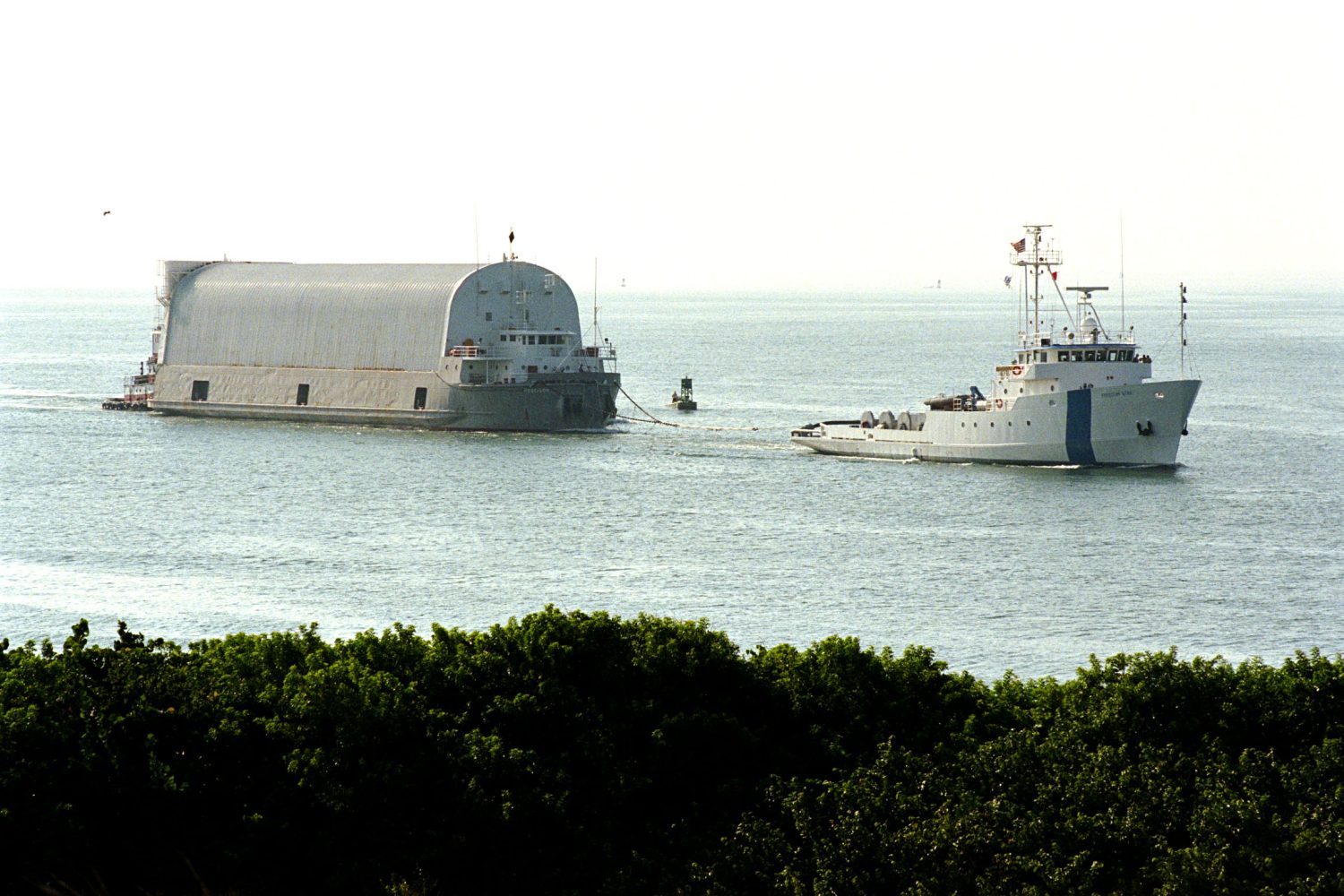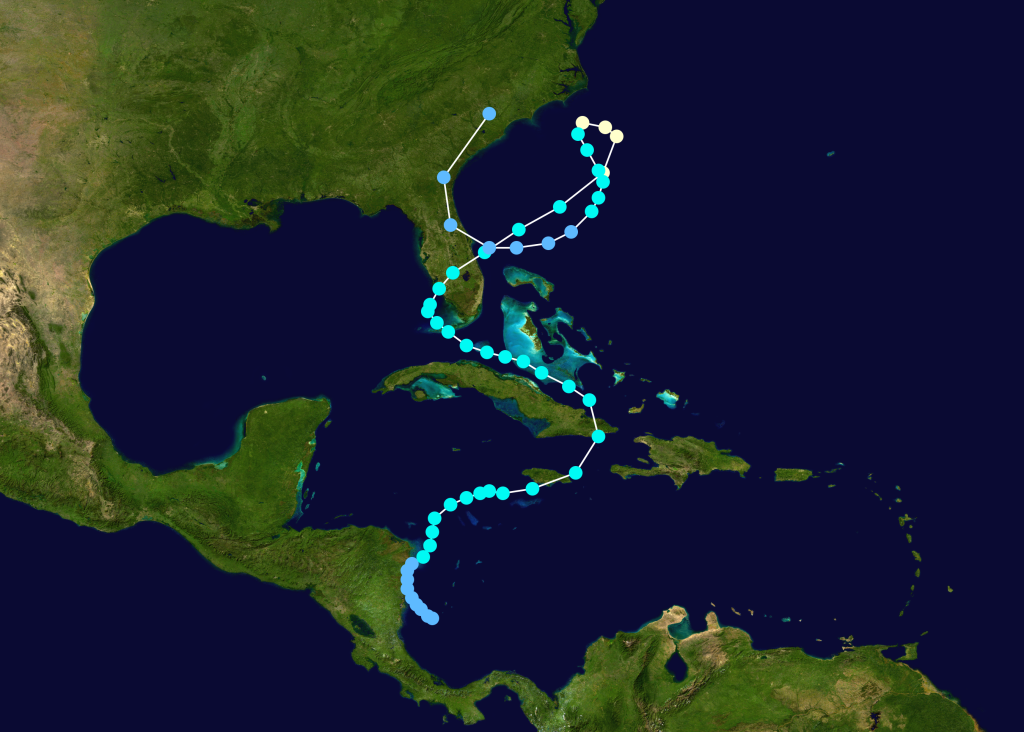
“‘Twas a dark and very stormy night, November 14-15, 1994…” is how the legal brief begins its description of events that led to the largest maritime salvage operation at the time. Space shuttle external tank 70 (ET-70) was aboard the barge Poseidon when Tropical Storm Gordon decided to make this trip from New Orleans to Cape Canaveral anything but ordinary.
Built by Martin Marietta (before merging with Lockheed) at the Michoud Assembly Facility in New Orleans, LA, ET-70 rolled off of the production line like so many others before. It was loaded onto the barge Poseidon, one of the predecessors to Pegasus still in use today, to be towed to the Kennedy Space Center in Florida to be added to the space shuttle stack. The 114-foot tug M/V J.A. Orgeron picked up Poseidon on November 10th and set sail for Florida.
That same day saw the naming of Tropical Storm Gordon. It was the result of two depressions that had combined two days earlier in the southwest Caribbean. Gordon’s path saw landfalls in Jamaica, Cuba, the Florida Keys and Fort Meyers. Gordon eventually became the third named hurricane of the season once it was back over the Atlantic Ocean. Uncharacteristically, however, it made a u-turn. First threatening the Carolinas, it eventually returned to shore over Cape Canaveral while weakening the whole time. Gordon eventually dissipated as a group of unnotable thunderstorms.

On November 14th, four days after departing New Orleans, The captain of the Orgeron, with Poseidon in tow, radioed the US Coast Guard to inform them that they had an engine failure, was adrift and ran the risk of running aground in Bethel Shoals near Fort Pierce, FL. But the Coast Guard was unable to help.
Enter, the Cherry Valley.
The M/V Cherry Valley was a 44,000-ton oil tanker that had left the port of Good Hope, Louisiana and was following almost the same course as the Orgeron on its way to Jacksonville, FL. Like any vessel, Cherry Valley‘s captain was watching the weather closely, including Gordon which, at this point, had claimed over 1400 lives on its path through the Caribbean. When the Orgeron had radioed their distress, the Cherry Valley was just 40 miles to the south. At the request of the Coast Guard, the Cherry Valley changed course toward the Orgeron to render whatever assistance it could.
Helping another vessel in distress is one of those rules that all ships sail by. It’s an action that goes back far in the history of sailing. But it does have a caveat: the ship coming to help is not required to put itself at any undue risk. The captain of the Cherry Valley could have easily said that it was too risky for his ship to help. With parts of the shoal at only 28 feet deep and the draft of the fully loaded oil tanker at 35 feet, the Cherry Valley ran the same risk of running aground as the Orgeron and Poseidon. But, being the good sailors they are, the crew of the Cherry Valley gave it a try knowing that, one day, it could be them who needs assistance and they would want some to try for them.
It took three tries, but on the morning of November 15th, the Cherry Valley managed to secure lines to the Orgeron and prevent them, and Poseidon, from grounding on the shoals. While this was going on, officials from NASA and Yowell International (the company contracted to perform the trips from New Orleans to Florida) were working on arranging alternate transport. They found the tug South Bend but when it arrived, and after waiting for a couple of hours for the winds to calm, it proved to be too weak and ended up taking on some water. Instead, the Cherry Valley, still holding on to the two wayward vessels, dropped anchor for the night.
Just after midnight, the Dorothy Moran had arrived. After waiting until morning, the Dorothy Moran took both vessels in tow. The Cherry Valley went on its way, the Dorothy Moran towed Poseidon to Cape Canaveral and then towed the Orgeron to Jacksonville for repairs. Everyone was safe, the storm had passed, and ET-70 was ready to fulfill its one purpose in life and would do so on STS-71. All was well, right?
Well, no. Now it was time to go to court.
As stated earlier, maritime traditions and laws go way back in history, even pre-dating laws of the land. When it comes to salvages, maritime law, in general, says that the rescuing ships are entitled to a reward based on the value of what was saved. When it comes to the Orgeron and Poseidon, just calculate what they’re worth if they were to be sold on the open market and a percentage of that is the reward. Seems simple enough. But what about ET-70? The value of that is, well, nothing. There is no market for a purpose built fuel tank designed to work only with the space shuttle. And what if they just claimed the tank itself for a reward? The Cherry Valley‘s crew and her captain, Prentice “Skip” Strong III, would have themselves one genuine piece of space hardware and nothing to do with it.
This is the dilemma that plagued the case as it was kicked around in District Courts and the Fifth Circuit Court of Appeals. It was decided that the reward would be determined based on the replacement value of an external tank. It was a messy process but if you want to read the court’s ruling and how they determined the salvage value, you can check it out here. Finally, on June 29th, 1998, Keystone Shipping, the operator of the Cherry Valley, was awarded $4,125,000. The crew was given 37% of the award amount. It was the largest salvage settlement in history at the time.
This story was found in the 3 volume book set titled “Space Shuttle: Developing an Icon.” There are plenty of other stories like this with tons of technical details and pictures galore! If you want to pick up a copy for yourself, head to the Amazon link below.
FTC: We use income earning auto affiliate links. More.


Comments